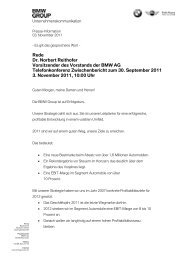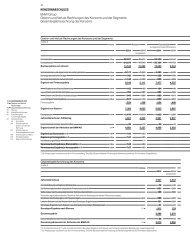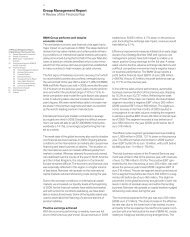Article by Prof. Dr. Hans Hunfeld (PDF, 151 KB). - BMW Group
Article by Prof. Dr. Hans Hunfeld (PDF, 151 KB). - BMW Group
Article by Prof. Dr. Hans Hunfeld (PDF, 151 KB). - BMW Group
Create successful ePaper yourself
Turn your PDF publications into a flip-book with our unique Google optimized e-Paper software.
TEGRATION ENGAGEMENT INVOLVEMENT EINWANDERER<br />
MIGRATION ENGAGEMENT ENTWICKLUNG EVOLUTION F<br />
VOLUTION EINWANDERER IMMIGRATION LERNEN LEARNI<br />
INTERESSE INTEREST LEBEN LIVING INTEGRATIION INTE<br />
ULTURELL INTERCULTURAL ENGAGEMENT INVOLVEMENT<br />
REIHEIT<br />
Von gemeinsamer<br />
FREEDOM<br />
Verschiedenheit<br />
INTERESSE<br />
lernen<br />
INTEREST LEBEN LIVING IN<br />
Jointly Learning from Diversity<br />
TEGRATION LERNEN LEARNING IDENTITÄT IDENTITY FRE<br />
DE STRANGERS INTERKULTURELL INTERCULTURAL INTE<br />
Principles of Intercultural Learning –<br />
for better knowledge of the LIFE concept<br />
An article <strong>by</strong> <strong>Prof</strong>. <strong>Dr</strong>. <strong>Hans</strong> <strong>Hunfeld</strong>, member of the jury<br />
of the <strong>BMW</strong> <strong>Group</strong> Award for Intercultural Learning
Introduction<br />
The following article translated <strong>by</strong> Friedrich Kratochwil, is an introduction to the “international curriculum<br />
for intercultural learning” which exemplifies and operationalizes the principles of the LIFE concept. This<br />
article appears in LIFE: Ideas and Materials for Intercultural Learning (Munich: <strong>BMW</strong> <strong>Group</strong>, 1997).<br />
In this article <strong>Hans</strong> <strong>Hunfeld</strong> defines intercultural learning as an understandable response to the fact that<br />
foreigners in the neighborhood have become a part of everyday life in modern society. As a result, formerly<br />
customary definitions of the foreigner must be examined, and our behavior towards him must change. The<br />
foreigner should no longer be dependent on our respective abilities to understand, he should no longer be<br />
understood in terms of, and thus have imposed upon him, our perception; he must above all be allowed to<br />
speak for himself more clearly than ever before. Intercultural learning educates us in how to deal with the<br />
normalcy of encountering foreigners among us.<br />
Every statement concerning intercultural learning is nowadays necessarily fragmentary. Intercultural<br />
learning, however, has in the meantime developed a tradition of its own. This tradition shows that the<br />
unreflected presentation of proposals, models or approaches for teaching is naïve when it is assumed<br />
that they are neutral and objective instead of being embedded in certain cultural contexts. Precisely<br />
because of the multitude of practical and theoretical efforts in different areas and disciplines, fitting a<br />
particular contribution within a general conceptual framework and assessing its comparative value have<br />
become difficult tasks. 1<br />
The risk is great of inadvertently repeating something which has already been said and of proposing an<br />
alternative that has already been tried. But in order to keep the discussion on intercultural learning open<br />
and to continue with this task, we have to run this risk in order to counteract special interests and narrow<br />
disciplinary understandings that dominate particular fields. What was always demanded from intercultural<br />
learning as an approach must also be demanded from those who want to practice it, in whatever form:<br />
there has to be a readiness to engage in a dialogue. The principles (originally elements of a curriculum),<br />
which are discussed below, were formulated in this spirit and with this understanding in mind.<br />
<strong>BMW</strong> <strong>Group</strong>
The normalcy of the foreigner<br />
1 Basics<br />
1.1 Taking intercultural learning seriously (for granted)<br />
Intercultural learning is not an arbitrary but rather a normal reaction to an obvious social<br />
problem. The foreigner is no longer somebody far away but s/he is among us and has thus<br />
become part of the “normalcy” of modern societies, even if he or she still is treated often as<br />
an anomaly or something exceptional. 2<br />
The often explicit refusal to deal in an enlightened, tolerant, and democratic fashion with<br />
the varieties of cultural and linguistic forms one encounters in everyday life makes special<br />
educational efforts necessary, if a community 3 wants to build its future on integration rather<br />
than on confrontation. The apparent contradiction between the factual changes in our<br />
societies on the one hand and the refusal to come to terms with them conceptually on the<br />
other suggests that we have to change the traditional practices and modes of thinking <strong>by</strong><br />
(un)learning. Another alternative simply does not exist. To that extent intercultural learning is<br />
the obvious mean of adjusting to these new circumstances so that living together peacefully<br />
becomes possible while mutually recognizing and accepting differences.<br />
1.2 The curriculum as an appeal<br />
The fundamental principle of intercultural learning is to engage in a dialogue. 4 Intercultural<br />
learning opens up one’s own understandings and unreflected assumptions to other points<br />
of view. It is this principle which informs the more particular goals and methods of the<br />
curriculum. To that extent it is not a simple prescription but rather an appeal. 5<br />
Because the curriculum is (still) based on the perspective of one country, it has the character<br />
of a preliminary proposal that invites other experiences and perspectives to contribute to<br />
this dialogue. Such openness, however, does not entail an attitude of “anything goes”<br />
(noncommittalism). Rather, the differences in intercultural learning resulting from particular<br />
cultural traditions are subordinate to common fundamental convictions, which are: tolerance<br />
for differences, the realization of a mutual give and take in all cultures, and recognition of<br />
the variety of expressions of a common humanity, which provide opportunities for mutual<br />
enrichment <strong>by</strong> complementing and enhancing one’s own tradition.<br />
The recognition that these assumptions have not been accepted in practice buttresses<br />
the appeal character of this curriculum in a variety of ways: intercultural learning, that up to<br />
now has taken place in a rather uncoordinated fashion, has to be coordinated internationally,<br />
its principles and guidelines have to be examined and be made operational, appropriate<br />
methodological and didactic approaches have to be formulated. This process of critical<br />
examination commences with the questioning of traditional concepts such as “the stranger”<br />
(foreigner), “understanding”, or “tolerance” 6 , all of which have to be freed from their largely<br />
ritualistic use as slogans. Instead, they have to be examined for their potential for contributing<br />
to our understanding in the face of fundamental changes in social reality.<br />
1.3 The normalcy of the foreign other<br />
What was foreign was never “normal”. Instead, it was always treated as “deviant” in terms of<br />
the taken-for-granted norm. The foreigner traditionally used to be a singular and extraordinary<br />
phenomenon and s/he was usually far away. S/he was stylized (the exotic), transfigured
(idealized) diminished (lesser breed), used (exploited), fought in war (enemy), and subjected<br />
(colonized). His/her characteristics were ascribed to him/her from the perspective of one’s<br />
own familiar culture. In a way, even his or her existence was the result of his discovery <strong>by</strong><br />
those who named him/her on the basis of their own world view and tradition. He or she<br />
was seldom allowed to speak since those who defined themselves through their technical<br />
progress and cultural superiority did most of the talking for him/her. The taken-for-granted<br />
dominance of the familiar facilitated such ascriptions and the relationship between normalcy<br />
and the “foreign other” was there<strong>by</strong> unilaterally determined and regulated. 7<br />
The reality of for example Europe or of the US today has, on the other hand, established<br />
the normalcy of the foreigner. This fact forces us to reconsider our conceptual gambits: the<br />
“foreign other” is no longer an extraordinary but rather a quite ordinary phenomenon. Indeed,<br />
the experience of the “other”, the foreigner, has become the normal. The living together of<br />
various ethnic groups can no longer be mastered <strong>by</strong> the self-assuredness of distance, which<br />
has disappeared not only in its spatial dimension. The “foreign other” speaks for himself,<br />
he or she no longer subordinates himself/herself to speeches made on his/her behalf, but<br />
instead wants to be heard. Since language functions not only as a mean of transmitting<br />
information but also as a constitutive element of our “world”, the ordinary presence of the<br />
“foreigner” also changes our traditional conceptual frameworks. Normalcy and otherness<br />
(foreignness) become mutually constituted distinctions, which are, however, no longer<br />
unilaterally determined. Intercultural learning alerts us to these facts of life and changes our<br />
traditional ways of conceiving of the world. 8<br />
1.4 The limits of understanding<br />
The existence of the foreigner among us does not depend upon individual capacity for<br />
understanding 9 .<br />
To conceive of understanding as a subsumption of the “other” under one’s own interest or<br />
life-plans is ruled out <strong>by</strong> the recognition that “otherness” and foreignness are ascriptions<br />
and not essential characteristics of persons and groups. The great variety of cultural and<br />
linguistic “others” limits our capacity for understanding. However, difference is legitimate<br />
even if it is not always “understood” <strong>by</strong> others. This lack of understanding does not relieve us<br />
from efforts to understand the other, and it does not legitimate our indifference towards it.<br />
Rather, it demands tolerance when the coexistence of people who experience each other as<br />
strangers has to be secured and when the acceptance of “otherness” cannot be based on an<br />
understanding of its character. Intercultural learning means therefore the reflective experience<br />
of the normalcy of the “foreign other” as a type of normalcy which is different and transcends<br />
one´s own capacity for understanding, but which is neither better nor worse than the familiar<br />
normalcy. 10<br />
1.5 The flexibility of “culture”<br />
The variety of cultural expressions is paralleled <strong>by</strong> attempts to classify them. 11 However, the<br />
syncretistic character of contemporary cultures, their mutual influences and impacts, calls<br />
static definitions into question. Intercultural dialogues and influence attempts are normal and<br />
ordinary phenomena; what is one’s “own” can hardly be determined with precision. Culture in<br />
modern societies consists rather in the simultaneous action of different modes of perception,<br />
traditions and customs which are changing all the time. Their boundaries are frequently rather<br />
diffuse. The contemporaneity of regional and global cultural phenomena, of understandings<br />
based on status and generational contexts, can no longer be subsumed under one single<br />
homogeneous concept of ”culture”. Every culture of one’s “own” is also dependent upon and<br />
develops within this overall process. Intercultural learning is therefore the lifelong realization of<br />
the mutual constitution and dependence of one’s own on the “foreign other”.
1.6 Preserving the foreign other<br />
The seemingly familiar robs the “other” of its own character and deprives the intercultural<br />
dialogue of its partner. Even wellmeaning efforts of unilateral empathy reduce the other to an<br />
object <strong>by</strong> their very naïveté of trying to understand it. Such efforts prevent what they attempt<br />
to bring about: an equal and mutually valued recognition of the other through a process<br />
of mutually getting to know each other. What one assumes to know already can no longer<br />
disclose itself. 12<br />
Consequently, intercultural learning does not intend to open up the “other” <strong>by</strong> a complete<br />
and comprehensive understanding – despite all of its efforts in this respect – but aims<br />
at leaving for it a space for development, for its contradictions and perhaps even for its<br />
enigmatic character, to which it is entitled, as is the “own” and the familiar.<br />
1.7 Recognizing the value of difference<br />
Differences, which are consciously perceived and accepted help us understand what we call<br />
our “own”. Foreign cultures and languages attain their importance for one’s own speech and<br />
actions because of their significant differences. They mark the distinctiveness of one’s own<br />
language and culture and enable us to see the mutual constitution of the “foreign” and the<br />
familiar. After all, individuality bases its identity on the relation to what is different. This insight,<br />
already formulated <strong>by</strong> Humboldt 13 , contradicts the presently popular opinion that one has first<br />
to be secure in one’s own identity before one can engage the “foreign other”. However, it is<br />
also clear that those “foreign others” have to be appreciated for themselves and must not be<br />
misused as counter-projections or foils for the construction of one’s own identity. It is the<br />
interest in the character of what is our “own” that leads to our curiosity in encountering the<br />
“foreigner” as an authentic, concrete and complete “other”, whose difference gives meaning<br />
to the boundaries of what we call our “own”. Intercultural learning therefore takes the<br />
acceptance of the foreign other as an opportunity for the student to gain insight and selfknowledge.<br />
1.8 The immediacy of the “foreigner”<br />
The foreigner who is presented to students through instructional materials can speak only<br />
indirectly to them. The selection of materials, influenced <strong>by</strong> notions of what is one’s “own”,<br />
always runs the risk of transmitting an interpretation that is in accordance with some particular<br />
instructional goal. To that extent, this type of learning can only be the preparation for the<br />
actual contact with foreigners. It goes without saying that it can do so only imperfectly and<br />
cannot substitute for the actual experience. This problem points to instructional necessities<br />
and possibilities different from those of the past. The authentic character of the “foreign” is<br />
best articulated when it is given room and when its presence is accepted. To that extent<br />
multilingual education will become more common, it will start earlier and will be pursued more<br />
intensively, relying on modern communication technologies that have been underutilized<br />
until now. Intercultural learning is a didactic principle 14 that transcends traditional disciplines<br />
and it cannot be sequestered to a particular field of instruction. It initiates and requires the<br />
expansion of modes of instruction and of learning. Both were based in the past on the<br />
monolingual experience that allowed only indirectly for some contact with authentic “others”.<br />
1.9 Intercultural learning as a focus<br />
If the “foreign” or otherness is allowed to remain the ”different” despite the fact that its<br />
nearness is accepted, then attempts at a comprehensive “understanding” are no longer<br />
necessary. In that case it is not the effort of comprehending the “foreign other” quantitatively
ut rather the qualitative change in the perception of the other that determines the conditions<br />
for success or failure of the dialogue one engages in. Traditional anthropology, area and<br />
cultural studies, which usually focus on typical universally observable phenomena, in a way<br />
contradict the goals of intercultural learning, which aims at understanding the foreign other<br />
as an individual instead of reducing him or her to a stand-in for his or her respective culture.<br />
Through contacts with the concrete foreigner, his or her individuality becomes central instead<br />
of the representative character, or the common stereotypes of a foreign nation, state, or<br />
culture. This personal encounter provides a richer engagement with a reality that is particular<br />
and concrete rather than general.<br />
The intercultural dialogue, which is the goal as well as the mean of learning, does not want<br />
to enlighten <strong>by</strong> a seemingly “objective” analysis of the different contexts of the respective<br />
interlocutors but focuses on the exchange of their personal experiences in such different<br />
contexts. The distance between different “life-worlds” is reflected <strong>by</strong> the personal conditions<br />
of the partners in the dialogue, not <strong>by</strong> the abstract nature of different cultural codes.<br />
1.10 Interferences with experiencing one’s own.<br />
Intercultural learning is impeded <strong>by</strong> pressures to conform, <strong>by</strong> the reduction of the individual<br />
to a role, <strong>by</strong> the manipulation of processes of learning and instruction, <strong>by</strong> pressures of public<br />
opinion, <strong>by</strong> the expansion of cultural uniformity 15 throughout the world, and <strong>by</strong> the suggestive<br />
impact of visual media based on the passive reception of images. However, such impediments<br />
to effective communication should no longer be taken as a drawback but rather as an<br />
opportunity and trigger for learning.<br />
Individuality in appearance and expression provides the opportunity for distancing oneself<br />
from this pressure to conformity in thought and action, if such individuality is not taken again<br />
as an occasion for voicing disapproval or for exerting pressure to conform. All in all, what is<br />
one’s “own” provides for variety, even before an explicit opening for an intercultural exchange<br />
has occurred. It is this existing variety that modifies the homogeneity and determinacy of<br />
expressions which are supposedly intrinsic to one’s sense of “ownness”. For example,<br />
literature and art support such a distancing and differentiation even in one’s own culture,<br />
particularly when they contradict the taken-for-granted interpretation of the world and when<br />
they are not “normalized” <strong>by</strong> means of tradited schools of thought.<br />
This openness to new experiences, so crucially important for intercultural learning, can<br />
therefore be trained in the encounters with one’s own culture <strong>by</strong> treating mistakes, deviations<br />
from the norm and its own contradictions, not as blockages but rather as opportunities for<br />
helping the learning process along. After all, these mistakes and deviations alert us to the<br />
relativity of all simplistic understandings of normalcy.<br />
1.11 Presuppositions of intercultural learning<br />
Intercultural learning needs certain presuppositions and conditions if it is to succeed. It<br />
cannot develop as long as the established systems of learning and instruction are selfrighteously<br />
preserved, when the common national approaches are egotistically practiced,<br />
and powerpolitical and economic interests are the main pursuits. Even if a pedagogical utopia<br />
does not simply settle for the possibilities achievable under given circumstances but relies<br />
on its own capacity to transform thought and action, it nevertheless needs a modicum of<br />
help for its development. This help is forthcoming only when the political will of accepting the<br />
changing realities and of molding the future together does not remain a mere declamation in<br />
and out of school.
1.12 Responsibilities of intercultural learning<br />
The daily encounter with the contrast between social and material security and care on<br />
the one hand, and of poverty and homelessness on the other hand, demonstrates the<br />
one-sidedness of traditional conceptions of culture and of learning, which are possible only<br />
if prosperity, safety, and shelter are guaranteed. The growing economic and psycho-social<br />
crisis we perceive in our midst as well as afar makes it impossible to deal with these problems<br />
eclectically or to act as if everything were ‘all right’. Intercultural learning recognizes that<br />
there is a common transcultural responsibility for narrowing the gap between the two global<br />
cultures: that of prosperity on the one hand, and poverty, exploitation and being at somebody<br />
else’s mercy on the other hand. 16<br />
2 Corollaries<br />
The normalcy of the foreign other and intercultural learning as an attempt to change the<br />
attitudes towards this normalcy have certain corollaries which are apparent but which are not<br />
always readily understood.<br />
2.1 Teaching attitude<br />
It is hardly realistic or achievable to expect a dramatic distancing from traditional teaching<br />
attitudes or methods and role conceptions that have been internalized. A self-righteous<br />
attitude of enlightenment, presumably based on special dedication, extensive experience<br />
with foreigners, or on superior teaching ability, is counterproductive for the dialogical character<br />
of intercultural teaching. This teaching style can only be learned from the experience of<br />
transcending the limits and calling into question what was up to this point considered the<br />
only thing normal and appropriate. An authoritarian approach to teachers’ education and<br />
further training and the unilateral direction of change prevent exchange, interaction, and<br />
openness but, above all, inhibit the readiness to risk something, to engage with something<br />
in one’s teaching that one needs still to appropriate for oneself.<br />
2.2 Questions and answers<br />
To ask a didactic question usually implies a not-so-hidden instruction to the student to<br />
reproduce the content of previous instructions. To question in this fashion, however, the<br />
up-to-this-point still “foreign” is impossible since such a procedure subverts its own raison<br />
d’être. An interculturally inspired question does not know the answer in advance. Practically,<br />
this means that the teacher has to fade into the background whenever the intercultural<br />
dialogue is being practiced, particularly in classes in which a variety of cultures are<br />
represented.<br />
2.3 Efforts at understanding<br />
Stereotypes, misunderstandings, and mistakes are all normal parts of learning. 17 If one tries<br />
to preemptively harmonize intercultural dialogues, one prevents them from achieving their<br />
goals, i. e. to provide insights into the necessary efforts for, and the latent dangers of mutual<br />
understanding. Intercultural training is not conflict-free and cannot succeed without some<br />
tensions. To get accustomed to the sound of a new language, to familiarize oneself with the<br />
articulations of another artform or literature, or to accept other lifestyles and worldviews as a<br />
normal phenomenon is a challenge which cannot be easily met, not to speak of ever being<br />
completely mastered.
2.4 Finding the “foreign” in what is one’s own<br />
The foreign has first of all to be (re-)discovered in the familiar. That one’s own language has<br />
been formed <strong>by</strong> “foreign” elements is demonstrated not only <strong>by</strong> foreign words but also in<br />
those parts of the language whose foreign origin is covered up as these elements have<br />
become part of one’s own culture (names, terms , conventions). Such discoveries show the<br />
naïveté of those modes of understanding which rely – due to their lack of knowledge – on<br />
what is one’s “own” (as the authentic yardstick). The ease with which e.g. the youth culture<br />
appropriates the “foreign” (anglicisms, use of English) shows the normalcy of foreign<br />
influences.<br />
2.5 Expectations and attitudes<br />
The authentic expression of the foreign other can contradict one’s own wellintentioned<br />
expectations. Thus, folks songs, myths and fairy tales might conserve certain images and<br />
interpretations which no longer correspond to the reality of the contemporary foreign culture.<br />
The intercultural dialogue is likely to be impeded <strong>by</strong> such a mode of engagement with a<br />
foreign culture. The example of the tourist who perceives abroad, above all, the exotic, and<br />
not the complexity and contradictory reality of a foreign culture, serves as a warning to all,<br />
particularly to those who teach, to be alert to their own prejudices. This caution is further<br />
enhanced <strong>by</strong> the paradoxical experience that travelers from highly industrialized nations<br />
blame the very cultures in foreign lands for the disappearance of the exotic idyl, while at the<br />
same time loudly bemoaning the lack of progress in these societies. Similar attitudes are<br />
expressed vis-à-vis the foreigner among us, e.g. when he or she is expected to behave in a<br />
fashion which is derived from some stereotype of the foreigner and not from the engagement<br />
with him or her as a person.<br />
2.6 Perspectives<br />
Intercultural learning makes transparent – whatever the themes, questions, or phenomena<br />
might be which give rise to it – above everything else the perspectival character of the world.<br />
It protects us from the homogenization of these differences and their absorption into the<br />
seemingly similar. Elemental forms and conditions of human existence (earth, fire, water,<br />
air), perceptual categorizations (time, space, directions) and their particular employment<br />
in different cultural contexts are the first occasions and triggers for learning. For example,<br />
rain, heat, or frost are, even within Europe, differently perceived and have different levels of<br />
importance. Similarly, East and West have culturespecific connotations, and “left” and “right”<br />
are (again) fraught with specific cultural meanings. The clearer these elementary distinctions<br />
are brought out and the more explicit their farreaching implications are made, the more our<br />
insight concerning the normalcy of differences as well as the relativity of one’s own normalcy<br />
is enhanced. Familiar meanings of colors when confronted with other strange interpretations<br />
provide further examples and thus an opportunity (of course not the only one) for making<br />
this point. For an effective intercultural dialogue it is crucially important that such different<br />
interpretations can be genuinely discussed and that they are listened to with an open mind<br />
and with curiosity.<br />
2.7 The “third culture”<br />
It cannot be the goal of intercultural learning to give up one’s own culture, to exchange it<br />
for the “foreign other”, or to get lost in a diffuse and uncritical multiculturalism. Intercultural<br />
learning leads, however, from the elemental step of distancing oneself from what is one’s<br />
own, via approaching the “foreign other” through understanding, to a characteristic position<br />
“in between” which has been called the “third culture”. 18 Taking this position lets us
experience what is familiar from the perspective of the “foreign other” without giving up what<br />
is our own or copying the foreign. Such a position of “in between” is manifest in a wide variety<br />
of degrees and forms in multicultural classes. It offers itself as a yardstick that should be<br />
utilized again and again.<br />
2.8 The threats of difference<br />
A careful and practical approach to cultural differences that exists in a given context for<br />
teaching and learning must not exclude the transcendence of this context and of its own<br />
presuppositions: the worldwide threat to these differences from a dominant western<br />
consumer culture 19 that is expressed in economic power and which manifests itself in the<br />
paradigmatic character that is to be emulated. Modern communication technologies which,<br />
on the one hand, could enhance our understanding, are on the other hand also able to<br />
dictate and manipulate the aims of this process of getting to know the ”other”. Intercultural<br />
approaches to learning utilize these technologies but critically reflect on the fact that the<br />
rapidity and frictionless character of modern communications can also serve interests which<br />
do not amount to a conversation or dialogue but to persuasion (or even seduction).<br />
2.9 Taken-for-granted knowledge<br />
Dialogues aiming at understanding take seriously the unproblematic knowledge possessed<br />
<strong>by</strong> participants but attempt to critically reflect upon it. Previous experiences with the “foreign<br />
other”, prejudices etc, are not corrected <strong>by</strong> relying on a seemingly objective knowledge but<br />
<strong>by</strong> confronting them with experiences and judgements of a different kind. They address<br />
there<strong>by</strong> the unreflective character of the individual or cultural prejudices while, at the same<br />
time, accepting the naïve attitude as a preliminary legitimate mode of experiencing and<br />
evaluating the “foreign other”. An intercultural didactic attempt to initiate such a critical<br />
dialogue without attempting to determine its course through directives. 21<br />
2.10 Intercultural enlightenment<br />
Where we have to fight hatred against the “foreign other” we need not necessarily educate<br />
people to love the unfamiliar ”other”. The (recognition of the) normalcy of the foreign other<br />
does not make allowances for stylizing or emphasizing this otherness. It also does not<br />
specifically demand some emotional attachment to it. Intercultural enlightenment therefore<br />
avoids moral appeals, which are wellmeaning but which reproduce the special character<br />
of the “foreign other” <strong>by</strong> denying its normal character and thus actually prevent the<br />
establishment of a normal neighborly attitude towards it. The materials and methods utilized<br />
in intercultural instruction and learning take particular care to be attentive to this problem.<br />
© Copyright 1997<br />
<strong>Prof</strong>. <strong>Dr</strong>. <strong>Hans</strong> <strong>Hunfeld</strong>, Universität Eichstätt, Universitätsallee 1, D-85071 Eichstätt
Footnotes<br />
1 It is a long time since one could get an overview of even only the<br />
relevant German-language publications <strong>by</strong> public authorities,<br />
journalists, academics, and of those publications of a methodologicaldidactic<br />
nature. And this is without reference to the “grey”<br />
publications market: various work papers, minutes, conference<br />
outcomes and the international output. Already in 1985, Klemm<br />
commented critically on this, p. 176: “The expansion (shown in the<br />
literature) of a concept is (...) not the result of theoretically cogent<br />
derivations or spectacular success in the practical realisation of a<br />
concept entitled “intercultural”. On the contrary: the (...) attempts<br />
to define what is subsumed under intercultural education are<br />
multifarious. The same holds true for descriptions of educational<br />
practice in which examples of intercultural work are communicated.<br />
“My list of references contains, apart from the cited works, those<br />
publications which attempt overviews, or give critical summaries,<br />
or classify and refer, or which seem important to me from the<br />
standpoint of my interests. At any rate, only a subjectivelydetermined<br />
selection. “For a newer, critical interim stocktaking of<br />
intercultural education, see Reich 1994.<br />
2 see Schmid, 1993, p. 200: “Immigration and multiculturalism are<br />
the norm in almost all modern societies, but a norm the normality<br />
of which involves it being repeatedly perceived as something<br />
new, as an exception or even as an anomaly.“ The European<br />
Parliament states: “The integration of the EU will lead to a further<br />
increase in crossborder mobility. It is true that this new mobility<br />
in the Community concerns other groups of people than those<br />
immigrating to the EU, ie labor which is usually more highlyqualified<br />
than most classical labor immigrants. But both trends lead to an<br />
increase and intensification of contacts between people of differing<br />
cultural, language and geographical origin. The integration of the<br />
EU and the globalisation of trade, transport and communications<br />
lead to cultural and linguistic diversity becoming the norm in the<br />
EU. Many citizens are consequently uncertain and fearful. Hence<br />
we cannot permit the integration of migrants to be only a topic for<br />
policy makers in special sectors. It has to be fought for in all areas<br />
of politics as a social policy issue par excellence. The European<br />
societies as a whole need new sustainable forms of integration”<br />
(European Parliament, PE 152.62/B, p. 5)<br />
3 see also: “... considering that the increase in intra-EU mobility<br />
and the immigration into the Community must not lead to the<br />
growth of further differentiation of education systems but on the<br />
contrary, challenges member states and with respect to their<br />
internal situations and legal systems to find new, specifically<br />
European solutions for a democratic discourse with cultural and<br />
linguistic diversity.“ (European Parliament, PE 163.895, p. 53)<br />
and “questions about society´s future are today more than ever<br />
societal questions directed at the education and training systems.<br />
If there is any one area of policy which can take on a key role in the<br />
process of integration, then it is doubtless education policy. It is true<br />
that it would be asking too much of education systems to expect<br />
them alone to cope with the future, but we cannot gain that future<br />
without a farsighted educational policy. What is at stake here is<br />
much more than merely qualifying young EU citizens for the labor<br />
market. It is just as much an issue of strengthening, implementing<br />
and expanding minority protection rights, waking understanding<br />
for cultural and linguistic diversity, developing respect for others,<br />
fostering tolerance and abolishing discrimination. The main issue is<br />
to give the notion of EU citizenship concrete shape and to breathe<br />
life into it, especially for young people.” (European Parliament, PE<br />
152.262/B, p. 5)<br />
4 see Roth 1991, p. 38: “In the multicultural society, dialogue´s<br />
function as an appeal has gained a fundamentally new currency.<br />
Dialogue with other cultures is not an event which occurs only<br />
during trips to other countries or in addressing the so-called Third<br />
World, but begins in one´s own country: as both opportunity<br />
and problem – and at any rate, as a fact which there is no getting<br />
around. Hence there is a noticeable increase in “dialogues” in<br />
intercultural thinking and work. Here too, this increase ought not<br />
to be put prematurely on one side as concept-inflation, but seen<br />
as expressing an urgent necessity. And as intercultural education<br />
neither can, nor wants to, ignore this concept, it seems obvious<br />
to look and see whether “dialogue” can be used to ground the<br />
discipline. Because the concepts of dialogue and consciousness<br />
which are not foreign to educational thought per se, acquire special<br />
meaning in intercultural education for the theoretical justification<br />
and legitimation of teaching activity in view of the living conditions<br />
of a multicultural society.”<br />
5 One should note: “The question of whether the envisaged<br />
learning outcome: improving the capacity for intercultural<br />
10<br />
communication, can be actually achieved <strong>by</strong> a corresponding<br />
learning program, has to remain unanswered. The rise in racist<br />
tendencies in Germany and other parts of Europe and the world<br />
in general illustrate what can be the enormous stubbornness of<br />
stereotypical attitudes towards everything that seems foreign. This<br />
fact alone gives rise to doubt as to whether a sensitivity program<br />
can do more than to reach those persons who have already<br />
reflected on their basic stance. One has to want to understand<br />
and no amount of direction can compel volition. Thus it does not<br />
seem appropriate to entertain too much idealism as regards the<br />
development of didactic materials for intercultural communication.<br />
But particularly given the existing problems, every attempt should<br />
be made to assist those willing to learn, as indeed us ourselves, and<br />
to question stereotypical thinking.” (Burghart 1994, p. 64)<br />
6 Some fundamental comments here are offered <strong>by</strong> Wierlacher<br />
1993.<br />
7 Some fundamental comments <strong>by</strong>: Greenblatt 1994, Kristeva<br />
1990 and Todorov 1982.<br />
8 see Luhmann/Fuchs 1989, p. 7.<br />
9 see Brenner 1989, p. 45: “The foreigner always remains strange:<br />
the familiarity which is the basis for understanding cannot occur<br />
because lifestyles are always defined <strong>by</strong> demarcation and not <strong>by</strong><br />
assimilation. In such demarcation processes, lifestyles do have to<br />
reflect on their own particularity <strong>by</strong> including the Other, but precisely<br />
for that reason, it is located as the strange and unfamiliar.” The<br />
observable experience of the boundaries of understanding the<br />
Other give rise to two alternative ways of thinking and acting: one<br />
can see the boundaries as not insuperable and thus try to extend<br />
the limited ability to understand; or one can see them largely as<br />
insuperable, accepting them as a basic hindrance to understanding<br />
the Other, and thinking and acting on that acceptance. Leaving<br />
aside armchair talk and street slogans and politicians´speechifying<br />
aimed at mindless acclamation, the current debate on foreigners<br />
is indeed oriented towards those alternatives, if I understand it<br />
correctly.<br />
10 see here also Kristeva 1990, p. 213: “a paradoxical society is<br />
coming into being, a community of foreigners, who accept each<br />
other to the degree that they perceive each other as foreigners.”<br />
11 see here Hinnenkamp 1994a, p. 3: “naturally, cultural, social<br />
and linguistic sciences offer clearly-defined concepts of culture:<br />
hermeneutic, structuralist, semiotic, cognitive, analytic etc. but one<br />
thing should be clear: Culture is not a simple quantity per se, nor is<br />
it static.It needs no national or societal consensus. Nor is it reducible<br />
to an internalised value system or to a habitus tailormade for people.<br />
Culture is many of (these) facets and modes of expression.”<br />
12 That applies also to the <strong>by</strong> now established concept: “In the<br />
enlightened current consciousness of western societies and in<br />
the political and scientific manifestations of that consciousness,<br />
the idea of interculturalism has established itself as a value which<br />
is hardly ever questioned. Too close are its ties to central political,<br />
cultural and ethical ideas for criticism of interculturalism not to<br />
run the danger of moral disapprobation. It is doubtless one of the<br />
most precious achievements of enlightened thought to have put<br />
paid to contempt of the outsider, at least in theory and in the name<br />
of humanity. But it is exactly this tradition which has left behind a<br />
fund of unresolved issues. An interculturalism in thought and deed,<br />
unenlightened as to its own constitutive conditions, threatens to fall<br />
victim to these issues.” (Brenner 1989, p. 37)<br />
13 “Language embraces more than anything else in people, it<br />
embraces the whole human race. It is precisely in its capacity to<br />
keep races apart that it unites the variety of the individualisms <strong>by</strong><br />
means of the mutual comprehension of foreign speech, without<br />
doing them harm.” (Humboldt, p. 117)<br />
14 see here the comments cited <strong>by</strong> Roth 1991, p. 46: “Intercultural<br />
education is seen not as a pedagogic task in its own right, which is<br />
to be performed in addition to the accustomed things which have<br />
been called for to date, but as a general principle, which has to be<br />
given due recognition in all areas of our education system“ (Hegele,<br />
1986, 158). “We would want intercultural education to become<br />
superfluous as a special area in general education, because the<br />
multiethnic and multicultural dimension is included in thinking<br />
about general education” (Essinger and Kula, 1987, 5) “Intercultural<br />
education is not a (new) special type of education, and no new<br />
definition of education. But intercultural education will be able to<br />
redefine the educational task.” (Borelli, 1986, p. 24)
15 See here Metz 1993, p. 225: “Are we Europeans possibly<br />
discovering the value of other cultures, the dignity of the Other´s<br />
Otherness, in a situation in which there are fewer and fewer of<br />
these culturally Other? Is it not the case that all cultures <strong>by</strong> now are<br />
subjects of a profane Europeanisation of the world? Has Europe<br />
not spread out over the whole globe <strong>by</strong> now – via its science and<br />
technology and information and communications industries? And<br />
does this profane Europeanisation of the world not also change the<br />
mentalities of the peoples it encounters?” and Schütze 1994, p. 68:<br />
“The foreign falls victim to the hegemony of a modern worldview.”<br />
16 see Schütze 1994, p. 74f: “There is no multicultural society –<br />
unless one took the conflict over the pros and cons of different ways<br />
of using a WC seriously, or fought against discriminating against<br />
garlic. There are only two cultures: the socially well-integrated and<br />
established part of humanity and the culture of poverty. The vast<br />
culture of poverty does not come under ethnic diversity, whose right<br />
of self-affirmation is the concern of multiculturalism. The poor, the<br />
violent even, are the foreigners who cannot behave as guests – so<br />
away with them. Whoever suffers from hunger has an unarticulated<br />
foreignness. He has no strength to socialise himself into becoming<br />
the Other. And the violence of the suburbs is indeed, as ritualised<br />
violence, quite close to the violence of life before its humanisation,<br />
but it is at the same time naked violence: it can neither be<br />
criminalised nor rehabilitated. There is no hope in the culture of<br />
poverty, which dominates a large part of the world. That culture is<br />
too far beyond the normal absorption capacity of the system. But<br />
the fact that this culture does not generate any differentiation is<br />
not enough to insert it into any sort of revolutionary construction.<br />
(...) unsentimental incomprehension, which is expressed in<br />
nothing but pragmatic indifference, governs attitudes to a poverty<br />
which confuses us, to impenetrable violence and to the hunger<br />
phenomenon, which will just not go away. They merely disconcert<br />
us, because they exceed our emotional capacity.”<br />
17 see Burghart 1994, p. 51: “So what is the particular problem<br />
underlying intercultural communication? Perhaps one could<br />
redefine it as follows: some of the knowledge each interaction<br />
partner contributes is not mutually congruent and yet each partner<br />
presupposes that the other sees it as self-evident. That need not lead<br />
to conflict but it can be assumed that the risk of incomprehension,<br />
misunderstanding or complete failure is larger when the normality<br />
expectations held <strong>by</strong> the interaction partners, and developed out<br />
of social experience, differ. If misunderstandings occur, they can<br />
be addressed and repaired <strong>by</strong> the discussants. But if they remain<br />
unrecognised and if this leads to a total failure of the interaction,<br />
the cause is seldom sought in one´s own understanding and much<br />
more frequently in the behaviour of the other. And this in turn is<br />
the source of stereotypes, ie widely-generalising, emotionallydetermined<br />
judgements frequently directed against groups”.<br />
18 see Kramsch 1993<br />
19 Critically, and in extenso: Schütze 1994<br />
20 see Brenner 1989, p. 51: “Unprejudiced understanding of the<br />
foreign cannot be achieved and where it is attempted, it leads only<br />
to unconscious prejudices succeeding behind the backs of the<br />
subjects.”<br />
21 see Roth 1991, p.46: “So the educational aim has to be not to<br />
devalue foreignness <strong>by</strong> labelling it “prejudices” but to comprehend<br />
it as the prerequisite for all learning processes and thus also for<br />
intercultural understanding. But educationalists must not remain at<br />
the level of verbalising this sort of notion, usually uttered emotionally:<br />
they should aim at raising conscious awareness of alienation<br />
experiences as normality, so as to make them accessible to<br />
individuals, there<strong>by</strong> creating for them the opportunity to deal with<br />
such experiences.”<br />
Literature<br />
Auernheimer, Georg: Einführung in die interkulturelle Erziehung.<br />
Darmstadt 1990.<br />
Balke, Friedrich u. a. (Hrsg.): Schwierige Fremdheit. Über Integration<br />
und Ausgrenzung in Einwanderungsländern. Frankfurt a. M.<br />
1993.<br />
Bausch, Karl-Richard/Christ, Herbert/Krumm, <strong>Hans</strong>-Jürgen (Hrsg.):<br />
Interkulturelles Lernen im Fremdsprachenunterricht. Arbeitspapiere<br />
der 14. Frühjahrs-konferenz zur Erforschung des Fremdsprachenunterrichts.<br />
Tübingen 1994.<br />
Borelli, Michele (Hrsg.): Interkulturelle Pädagogik. Positionen<br />
– Kontroversen – Perspektiven. (= Interkulturelle Erziehung in<br />
Theorie und Praxis 4). Baltmannsweiler 1986.<br />
Brenner, Peter J.: Interkulturelle Hermeneutik. Probleme einer<br />
Theorie kulturellen Fremdverstehens, in: Zimmermann, Peter<br />
(Hrsg.): Interkulturelle Germanistik. Frankfurt 1989.<br />
Burghart, Martin: Ein Algorithmus zum interkulturellen Verstehen.<br />
Die Idee eines Lernprogramms zur Verbesserung der interkulturellen<br />
Kommunikationsfähigkeit für Einzellerner, in: Heringer<br />
1994, S. 51-65.<br />
Essinger, Helmut/Bilde Kula, Onur: Pädagogik als interkultureller<br />
Prozess. Beiträge zu einer Theorie interkultureller Pädagogik.<br />
Felsburg/Istanbul 1987.<br />
Europäisches Parlament: Entschließung A3-0399/92. Zur kulturellen<br />
Vielfalt und den Problemen der schulischen Bildung der<br />
Kinder der Einwanderer in der Europäischen Gemeinschaft (PE<br />
163.845/PE 152.262B).<br />
Greenblatt, Stephen: Wunderbare Besitztümer. Die Erfindung des<br />
Fremden: Reisende und Entdecker. Berlin 1994.<br />
Harth, Dietrich: Fiktion des Fremden. Erkundung kultureller Grenzen<br />
in Literatur und Publizistik. Frankfurt a. M. 1994.<br />
Heringer, <strong>Hans</strong> Jürgen/Hinnenkamp, Volker (Hrsg.): Interkulturelle<br />
Kommunikation (= Sprache und Literatur in Wissenschaft und<br />
Unterricht), 74, 1994 (a).<br />
Hinnenkamp, Volker: Studienbibliographie Interkulturelle Kommunikation.<br />
Heidelberg 1994 (b).<br />
Hölscher, Petra (Hrsg.): Interkulturelles Lernen. Projekte und<br />
Materialien für die Sekundarstufe I. Frankfurt a. M. 1995.<br />
Humboldt, Wilhelm von: Gesammelte Schriften, Bd. VI. Hrsg. von<br />
der Königlich Preussischen Akademie der Wissenschaften. Berlin<br />
1903-1936. Reprint Berlin 1968.<br />
Klemm, Klaus: Interkulturelle Erziehung – Versuch einer Eingrenzung,<br />
in: Die deutsche Schule, 3, 1985, S. 176-187.<br />
Kramsch, Claire: Context and Culture in Language Teaching.<br />
Oxford 1993.<br />
Kristeva, Julia: Fremde sind wir uns selbst. Frankfurt a. M. 1990.<br />
Larcher, Dietmar: Kulturschock. Fallgeschichten aus dem sozialen<br />
Dschungel. Meran 1992.<br />
Luhmann, Niklas/Fuchs, Peter: Reden und Schweigen. Frankfurt a.<br />
M. 1989.<br />
Metz, Johann Baptist: Das Christentum und die Fremden. Perspektiven<br />
einer multikulturellen Religion, in: Balke u. a. 1993, S.<br />
217-228.<br />
Nieke, Wolfgang: Interkulturelles Lernen und interkulturelle<br />
Erziehung – Zielsetzungen und Realisierungsmöglichkeiten, in:<br />
Lernen für Europa. Informatio-nen zu Projekten des sprachlichen<br />
und interkulturellen Lernens 2. Hrsg. vom Landesinstitut Soest<br />
1992, S. 44-56.<br />
Reich, <strong>Hans</strong> H.: Interkulturelle Pädagogik – eine Zwischenbilanz,<br />
in: Zeitschrift für Pädagogik, 40, 1994, 1, S. 9-27.<br />
Roth, <strong>Hans</strong> Joachim: Dialog und Bewusstsein – Überlegungen<br />
zum Menschenbild in der interkulturellen Pädagogik, in: Lernen<br />
in Deutschland. Zeitschrift für interkulturelle Erziehung, Mai 1991,<br />
S. 37-51.<br />
Schmid, Thomas: Der Fremde als Provokateur und Entwicklungshelfer.<br />
Szenen aus der Geschichte der Aus- und Einwanderung,<br />
in: Balke u. a. 1993,<br />
S. 200-216.<br />
Schütze, Jochen K.: Von der mangelnden Fremdheit des Anderen,<br />
in: Berger, Albert/Moser, Gerda Elisabeth (Hrsg.): Jenseits des<br />
Diskurses. Literatur und Sprache in der Postmoderne. Wien 1994,<br />
S. 57-75.<br />
Todorov, Tzvetan: Die Eroberung Amerikas. Das Problem des<br />
Anderen. Frankfurt a. M. 1982.<br />
Wierlacher, Alois (Hrsg.): Kulturthema Fremdheit. Leitbegriffe und<br />
Problemfelder kulturwissenschaftlicher Fremdheitsforschung.<br />
München 1993.<br />
Neuere Arbeiten des Verfassers zum Thema:<br />
Fremdheit als Lernimpuls. Skeptische Hermeneutik – Normalität<br />
des Fremden – Fremdsprache Literatur. Meran 2004.<br />
11
This text can be ordered from:<br />
<strong>BMW</strong> <strong>Group</strong><br />
Corporate Communications<br />
D-80788 München<br />
fax: +49-(0)89-35 84 68 61<br />
e-mail: presse@bmw.de<br />
12







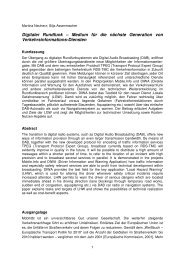
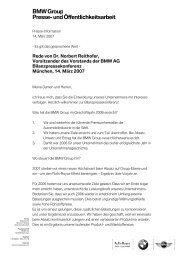


![Vollständiger Bericht [PDF] - BMW Group](https://img.yumpu.com/20706531/1/190x238/vollstandiger-bericht-pdf-bmw-group.jpg?quality=85)
